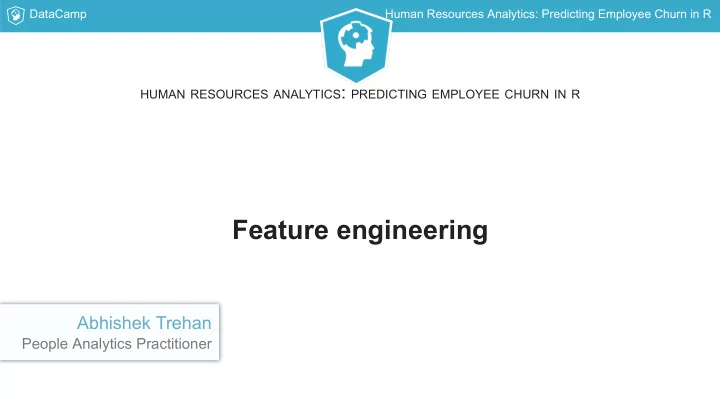

DataCamp Human Resources Analytics: Predicting Employee Churn in R HUMAN RESOURCES ANALYTICS : PREDICTING EMPLOYEE CHURN IN R Feature engineering Abhishek Trehan People Analytics Practitioner
DataCamp Human Resources Analytics: Predicting Employee Churn in R Feature engineering Basic variables : Set of variables available directly in a dataset Derived variables : Set of variables derived using data transformation of basic variables
DataCamp Human Resources Analytics: Predicting Employee Churn in R Creating new features Age difference between an employee and their manager Job-hop index Employee tenure
DataCamp Human Resources Analytics: Predicting Employee Churn in R Age difference Views Handling pressure Expectations Work ethics
DataCamp Human Resources Analytics: Predicting Employee Churn in R Job-hopping Total experience Job-hop index = Number of companies worked
DataCamp Human Resources Analytics: Predicting Employee Churn in R Employee tenure Tenure : duration of employment Inactive employees tenure date_joining & last_working_date Active employees tenure date_joining & cutoff_date
DataCamp Human Resources Analytics: Predicting Employee Churn in R Deriving employee tenure # Coercing date variables from dd/mm/yyyy format library(lubridate) org_final %>% mutate(date_of_joining = dmy(date_of_joining), cutoff_date = dmy(cutoff_date), last_working_date = dmy(last_working_date))
DataCamp Human Resources Analytics: Predicting Employee Churn in R Calculating timespan # Computing time span in years library(lubridate) date_1 <- ymd("2000-01-01") date_2 <- ymd("2014-08-09") time_length(interval(date_1, date_2), "years") [1] 14.60274
DataCamp Human Resources Analytics: Predicting Employee Churn in R HUMAN RESOURCES ANALYTICS : PREDICTING EMPLOYEE CHURN IN R Let's practice!
DataCamp Human Resources Analytics: Predicting Employee Churn in R HUMAN RESOURCES ANALYTICS : PREDICTING EMPLOYEE CHURN IN R Compensation Abhishek Trehan People Analytics Practitioner
DataCamp Human Resources Analytics: Predicting Employee Churn in R Compensation matters Compensation is one the top drivers of employee turnover Pay matters for employee retention
DataCamp Human Resources Analytics: Predicting Employee Churn in R Exploring compensation variable # Plot the distribution of compensation ggplot(emp_tenure, aes(x = compensation)) + geom_histogram()
DataCamp Human Resources Analytics: Predicting Employee Churn in R Exploring compensation variable # Plot the distribution of compensation across levels ggplot(emp_tenure, aes(x = level, y = compensation)) + geom_boxplot()
DataCamp Human Resources Analytics: Predicting Employee Churn in R Deriving Compa-ratio Actual Compensation Compa Ratio = Median Compensation
DataCamp Human Resources Analytics: Predicting Employee Churn in R Deriving Compa-ratio Compa-ratio of 1.2 or 120% means that the employee is paid 20% above the median pay Compa-ratio of 1 or 100% means that the employee is paid exactly the median pay Compa-ratio of 0.8 or 80% means that the employee is paid 20% below the median pay
DataCamp Human Resources Analytics: Predicting Employee Churn in R Deriving median compensation & compa-ratio # Derive Compa-ratio emp_compa_ratio <- emp_tenure %>% group_by(level) %>% mutate(median_compensation = median(compensation), compa_ratio = (compensation / median_compensation)) # Look at the median compensation for each level emp_compa_ratio %>% distinct(level, median_compensation) # A tibble: 2 x 2 # Groups: level[2] level median_compensation <fct> <dbl> 1 Analyst 51840 2 Specialist 83496
DataCamp Human Resources Analytics: Predicting Employee Churn in R Deriving Compa-level Compa-ratio > 1: Above Otherwise: Below
DataCamp Human Resources Analytics: Predicting Employee Churn in R HUMAN RESOURCES ANALYTICS : PREDICTING EMPLOYEE CHURN IN R Let's practice!
DataCamp Human Resources Analytics: Predicting Employee Churn in R HUMAN RESOURCES ANALYTICS : PREDICTING EMPLOYEE CHURN IN R Information value Abhishek Trehan People Analytics Practitioner
DataCamp Human Resources Analytics: Predicting Employee Churn in R Understanding Information value Measure of the predictive power of independent variable to accurately predict the dependent variable Rank independent variables on the basis of their predictive power
DataCamp Human Resources Analytics: Predicting Employee Churn in R Calculating Information value % of non-events ∑ IV = ( (% of non-events - % of events)) ∗ log( ) % of events
DataCamp Human Resources Analytics: Predicting Employee Churn in R Calculating Information value # Load Information package library(Information) # Compute Information Value IV <- create_infotables(data = emp_final, y = "turnover") # Print Information Value IV$Summary Variable IV 12 percent_hike 1.144784e+00 17 total_dependents 1.088645e+00 21 no_leaves_taken 9.404533e-01 31 tenure 9.332570e-01 27 mgr_effectiveness 6.830020e-01 11 compensation 6.074885e-01
DataCamp Human Resources Analytics: Predicting Employee Churn in R Information value (IV) table Information value Predictive power < 0.15 Poor Between 0.15 and 0.4 Moderate > 0.4 Strong percent_hike : 1.14 (Strong) compa_ratio : 0.29 (Moderate)
DataCamp Human Resources Analytics: Predicting Employee Churn in R HUMAN RESOURCES ANALYTICS : PREDICTING EMPLOYEE CHURN IN R Let's practice!
Recommend
More recommend